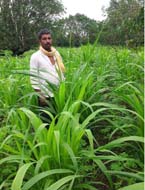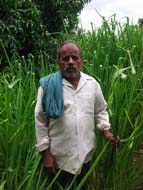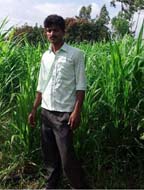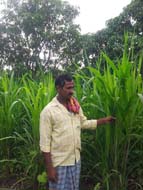 Shrinking farm size has consequence in apportioning it for perennial fodder cultivation by farmers. Non competitive land use for fodder production is hence inevitable to meet fodder deficiency situation. Karnataka is one of the important mango (Mangifera indica L.) producing states of the country. Inter row spaces in prime fruiting mango orchards provide opportunity for cultivation of perennial fodder crops. The common mango planting distance followed is 10 m by 10 m giving minimum 7-8 m inter space for introducing fodder crops. Karnataka has an estimated 90,000 ha in prime fruiting mango crop which if put under fodder crops is estimated to produce 39.5 lakh tons of green fodder in a year meeting more than seven lakh livestock’s green fodder requirement round the year. This potential niche area was exploited successfully for introduction of improved high yielding fodder crops through participatory mode. The process started with pilot activity in 2013-14 covering only five mango growers in an area of five acres. The reassuring response received was en-cashed by scaling up in 2014-15 by linking with livestock based voluntary organizations to shorten rapport building time, series of field oriented trainings to farmers enabling them to select fodder species as per their resource matrix, providing seeds and planting materials, reconnaissance and data collection on diverse parameters including farmer to farmer spread of these crops.
Shrinking farm size has consequence in apportioning it for perennial fodder cultivation by farmers. Non competitive land use for fodder production is hence inevitable to meet fodder deficiency situation. Karnataka is one of the important mango (Mangifera indica L.) producing states of the country. Inter row spaces in prime fruiting mango orchards provide opportunity for cultivation of perennial fodder crops. The common mango planting distance followed is 10 m by 10 m giving minimum 7-8 m inter space for introducing fodder crops. Karnataka has an estimated 90,000 ha in prime fruiting mango crop which if put under fodder crops is estimated to produce 39.5 lakh tons of green fodder in a year meeting more than seven lakh livestock’s green fodder requirement round the year. This potential niche area was exploited successfully for introduction of improved high yielding fodder crops through participatory mode. The process started with pilot activity in 2013-14 covering only five mango growers in an area of five acres. The reassuring response received was en-cashed by scaling up in 2014-15 by linking with livestock based voluntary organizations to shorten rapport building time, series of field oriented trainings to farmers enabling them to select fodder species as per their resource matrix, providing seeds and planting materials, reconnaissance and data collection on diverse parameters including farmer to farmer spread of these crops.
In second year 25 mango growers of 11 villages of Karnataka cultivated fodder crops in inter spaces of mango orchards covering an area of 25.05 acres. Three perennial grasses (Bajra Napier hybrid-BNH, Guinea-G, Perennial fodder sorghum-PS) intercropped with fodder cowpea (CP) were cultivated by 32% mango growers, two grasses (BNH+G) by 28%, BNH alone by 12% and 8% each two grasses (BNH+PS) or one grass and one legume (BNH+CP, PS+CP) and 4% cultivated two grasses intercropped with fodder cowpea.



During the project period, intra-farmer spread of area under fodder crops in interspaces was 17 % by 24% participating farmers. The area under fodder crops was thus increased by 45% thus increasing total area under fodder crops to 36.4 acres from initial 25.05 acres. With the 5 acres in the initial pilot period, the total area brought under fodder crops in mango orchard stands at 41.4 acres. Participating farmers reported many benefits on themselves, on their livestock rearing and on mango orchard per se. On livestock rearing, decrease in feed cost (88%) and improvement in livestock health (84%) by feeding improved fodder was reported. It helped them to decrease feed cost by 44.20% and increased average milk yield by 0.93 litres saving 1.37 km of daily distance treading to collect fodder and one manday every day for the same purpose. Reduction in orchard temperature (100%), weed intensity (92%), soil erosion (88%), pest (68%) and disease (64%) occurrence and improvement in water penetration (84%) were the benefits reported on mango orchard.
Earlier, the participating farmers were experiencing shortage of about 22% green fodder and 17% dry fodder. The project interventions helped them not only to effectively mitigate this fodder shortage but surplus production was observed with many farmers. The average green fodder production obtained was 55.49 tons/ha across 2.7 cuts. Use of non competitive land of orchard crops for improved fodder production not only alleviates fodder deficiency, but brings multiple benefits to livestock farmers.
(Source: ICAR-Indian Grassland and Fodder Research Institute ,Southern Regional Research Station, Dharwad-580 005, Karnataka)







फेसबुक पर लाइक करें
यूट्यूब पर सदस्यता लें
X पर फॉलो करना X
इंस्टाग्राम पर लाइक करें